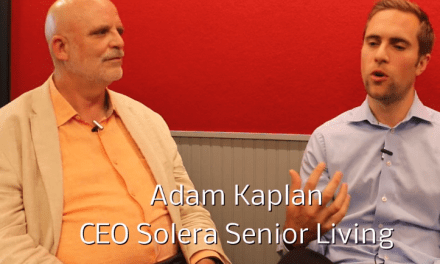The continuing care industry allows responsible aging adults to avoid the possibility that they may become dependent on family or government because of age-related disabilities
By Jack Cumming
The continuing care industry allows responsible aging adults to avoid the possibility that they may become dependent on family or government because of age-related disabilities. Responding to that wish requires a lifetime commitment to meet needs when, as, and if they occur.
That’s good policy for those who take the step. It’s also good policy for the nation, enabling Americans to provide for themselves instead of looking to government. Prepaid continuing care for life should be preserved and encouraged. It may, however, be in danger.
It’s For Life
By accepting that lifelong commitment, and undertaking to manage the consequent risk, the continuing care industry differentiates itself from the assisted living industry and from the post-acute care industry, which is month-to-month or even day-to-day. Entrance fees allow people to pre-fund part of their future care. It’s a valuable financial planning tool for those facing age-related uncertainties.
That the continuing care industry struggles with the idealism of its continuum of care commitment is evident in the evolution of names for its product. The designation lifecare community from long ago evolved to Continuing Care Retirement Community (CCRC), which often involved a lesser consumer-protective element than originally. More recently there has been an effort to rebrand the product as Life Plan Community, in the belief that renaming can result in wider popular acceptance.
The commitment that care will be there as needed is what makes the entrance fee continuing care model conscionable for those who are still independent. The alternative is the Active 55+ community model which offers ownership. Missing from Active 55+ communities is the commitment to ensure the welfare of people if they lose cognition or physical function. Such communities are often surrounded by assisted living and other providers, but there is no inherent commitment to a continuum of care at an affordable price.
Sound Public Policy
The entrance fee mechanism allows people to prepare for the future while they still have independence and cognitive discernment. It’s sound public policy to encourage such self-sufficiency.
Public policy is a delicate balancing of the ideal with the pragmatic. Political manipulations can upset that balance. Still, in the ideal, sound policy rises above partisanship to seek solutions to thorny societal challenges, one of which is how best to finance and deliver the services that people need as they move through the transitions of aging.
For the elderly in America, it has been the senior housing industry – both nonprofits and for-profits – that has led the nation by pioneering the ideal solution, a continuum of care to preserve human dignity for life.
Managing Risk
In a recent email directed to actuaries, AV Powell, a leading advocate for scientific risk management, voiced apprehension that the entrance fee funded continuing care contract might soon disappear. Mr. Powell is not alone in his concern, though he is, perhaps, better positioned to note the trend.
Mr. Powell fears a parallel with the decline of defined benefit pension plans. That decline reflected a business aversion to managing investment, tax-policy, and longevity risks. Employers, uncomfortable with their risk exposure, shifted retirement risk to employees through 401(k) and similar programs. Previously, employers had managed that risk with actuarial principles.
Mr. Powell observes that continuing care contracts have been a form of managed care that has worked effectively to enable people of moderate net worth to pay an entrance fee to assure their future. In his email to actuaries, he affirmed that he has “never found a situation where a CCRC has gone bankrupt due to adverse actuarial experience.” Of course, the same cannot be said for over-optimistic market studies since no CCRC can thrive with adverse occupancy.
It is actuaries’ mastery of risk forecasting that distinguishes them from accountants. Their expertise goes well beyond merely preparing reports. They can guide providers to manage risk, for instance, by arranging reinsurance, or an inter-insurance exchange (IIE), to shield providers of risks to which they are averse. Reinsurance and IIEs – like insurance generally – simply transfer risk from an entity that is ill-equipped to manage it to an entity that is.
The alternative is to shift risk from the provider to their resident-consumers. The risk remains. The question for senior housing is whether risk is spread across many or concentrated on the few.
Providing for the Future
An upfront entrance fee can assure that funds will be available later to meet resident needs. Some providers use rules of thumb. One provider, for instance, has said, with scant data analysis, that entrance fees roughly offset the cost of end-of-life care, so he uses fees from new residents to cover the costs for those whose lives are drawing to a close.
Accountants use a plausible, though questionable, amortization concept to reflect the deferred performance obligations funded by entrance fees. Actuaries, typically, create more sophisticated economic projection models, which are self-refining with accuracy improved over time as actual experience evolves. These models have more rigor than does the limited accounting concept of amortization.
Matching of revenue recognition with commitments, the actuarial approach, is consistent with the accounting matching principle. The amortization concept is less principled.
Reserving
If balance sheet liabilities are correctly determined, then the release of those liabilities as deferred performance obligations are fulfilled, will exactly offset the fulfillment costs. Since many providers do not now hold such liability reserves, they are sometimes caught unprepared as a resident population ages into care needs.
Holding liability reserves does not affect the investment of the corresponding assets. They can be invested in buildings and equipment, debt reduction, or whatever, as long as sufficient liquidity is maintained to meet developing cash needs as they fall due.
Debt undertakings are generally senior to other equity forms of enterprise investment. There is a residual question whether it is ethical to use entrance fees, which are solicited as contractual consideration, to provide the junior at-risk financing element for debt. That is less a concern among owner-financed for-profit providers than it is among not-for-profits.
The Looming Threat
Accepting entrance fees, or even promising to harbor the elderly for life, involves a trust commitment to ensure that benefits can be provided as they are needed. We have achieved that level of assurance for banking with the FDIC and, for insurance, with state guaranty funds.
Recently, there have been a number of publicized cases of CCRCs that have failed. There are also cases in which residents with lifetime continuing care contracts have had to move because the enterprise they trusted is unable to meet their needs either internally or through outsourcing. As these stories percolate outward through the larger community, they imperil the ongoing acceptability of the continuum of care model.
These troubling trends tend to mirror providers’ sense of their inadequacy to manage the associated risks. The danger is that providers, first, abandon the full care inclusive, Type A, model and, then, abandon the lifetime entrance fee model to give preference to month-to-month contracting. That shift of risk from providers to less sophisticated consumers can still be reversed with a more risk management understanding on the part of providers.
Socio-Economic Value
The entrance fee CCRC approach to lifetime aging security has worked best for middle-income to affluent customers. The wealthy and very wealthy generally prefer to keep their autonomy. Lower income and indigent older people are dependent on the social safety net, such as it is.
It’s safe to say that everyone has the same risk of needing lifetime care. The question is whether it can be planned for, and pre-financed, or if it has to be met on an ad hoc, pay-as-you-go basis. It’s also safe to say that the current system, which is largely no system, works better for those who are wealthy than it does for the indigent.
Housing, despite federal programs, remains a challenge for the indigent, since programs like Medicaid, Community-Based Adult Day Care, and the Program for All-Inclusive Care for the Elderly, do not ensure suitable housing. Needless to say, government assistance for low-income elderly comes with considerable regulatory and accountability overhead.
Entrance Fee Care is Critical
The entrance fee model fills an important need for individual security. It is at its best when the provider organization accepts the risk exposures, takes trust responsibility for the well-being of all residents, and has the financial wherewithal to meet the most stringent solvency standards. My understanding of the concern, voiced by AV Powell, but shared by many, is fear that the security blanket which entrance fee CCRCs provide to middle-income Americans may be lost.
Senior housing is a caring industry. It also benefits when data and scientific principles guide pricing, funding, and other financial aspects. The combination of entrance fees as a financial planning tool with the assurance of care throughout life is critical to sound policy for aging in America. Let’s hope it can be preserved.
Webinar Opportunity
AV Powell will be hosting a webinar on Tuesday, March 5th, at 1:00 PM EST with the title “What do Prospects and Residents Need to Know about Actuarial Studies?” Click here to view the presentation part of the webinar.








